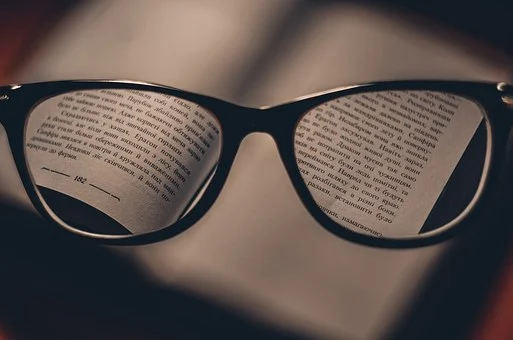Close Focus and Reading
f you look through a single lens reflex camera or camcorder, you have to rotate the barrel of the lens to adjust its focus (unless it’s an autofocus camera, of course). If you focus at a distance, things close up are blurry, and vice versa. The human eye works in similar fashion. Without any effort, the optically ideal eye sees distant objects easily. To look at something up close, focus must be adjusted; this occurs by a process called accommodation. A circular muscle behind the iris (the ciliary muscle or ciliary body) contracts and moves forward slightly. This muscle is connected to the lens by a network of tiny fibers called zonules. The change in tone and position of the ciliary muscle changes the tension of the zonules on the lens.

his change in “tug” causes the lens to change its’ curvature, increasing its’ focusing power.
In our youth, the lens is very flexible and accommodates easily. As we mature, the lens grows in a fashion similar to the trunk of a tree. Layers of protein are deposited over time like the rings on a tree trunk, causing the lens to become thicker, denser, and less flexible. After a certain point, close focusing becomes difficult, and people need to use magnifying glasses to see near objects without eyestrain. This condition, called presbyopia, usually begins in the mid-forties and gets progressively worse for about 15 years.
Presbyopia and LASIK
If you are in your mid-forties and have mild myopia (up to -3.00), you probably have discovered that it is more comfortable to focus up close and read without your distance glasses. If you have PRK or LASIK, your distance vision will be corrected, but you may find it more comfortable, or necessary, to wear reading glasses for comfort up close. This is because no type of vision correction surgery can eliminate or reverse presbyopia, which is a part of the natural aging process of the eye. Laser treatment can permanently reduce or eliminate myopia, hyperopia and astigmatism; but it cannot reverse, reduce, or eliminate presbyopia.
Monovision and other options for people over 45 who desire vision correction
If both eyes are perfectly corrected for distance, one can use “drug-store type” reading glasses for close viewing. Another option is to adjust one eye to have better close focus than distance clarity. This is referred to as monovision (mono for one – one eye for distance, one for close), and is an acceptable option for many (but not all!) individuals who desire to avoid reading and distance glasses for as long as possible.
Monovision, like reading glasses and bifocals, is not a perfect solution to the optical challenges of presbyopia. It is at best a compromise. And it is not for everybody. If a group of people (all appropriate candidates with equal prescriptions) are given a chance to try monovision correction with soft contact lenses, roughly a third will like it and desire to adopt monovision. About a third will find it uncomfortable, unbalanced or otherwise unacceptable, and will prefer having both eyes corrected equally (for distance). The remaining third may grumble about monovision with the same intensity that they would lament the shortcomings of bifocals, and will be ambivalent about any long-term commitment to monovision.
The best way to know if you will like monovision-type correction by laser treatment is to experience it first in contact lenses. If you already wear monovision correction in soft lenses, you already know the answer. At BEST LASIK Laser Eye center, we demonstrate monovision correction (via soft lenses) to all individuals over 40 or so who come in to discuss laser care (if they have not tried this previously). This is quite like trying on a pair of shoes before you buy them. We find that satisfaction with laser treatment is extremely high if people understand the limits of presbyopia and participate in the process of choosing whether or not to have monovision-style treatment.
Until very recently, artificial lenses implanted at the time of cataract surgery were all single-focus or fixed-focus lenses. So, even if distance vision could be rendered optimal with such care, reading glasses would still be necessary. It is self-evident that any patient who may contemplate cataract-style surgery would want to enjoy clear distance vision, clear reading vision, and clarity everywhere in between, without need to use glasses.
Significant challenges exist in designing a lens implant that can accommodate, or adjust for close focus. Such a lens will (if and/or when it can be developed) possibly revolutionize the treatment of cataracts, and may also offer a surgical treatment for presbyopia.
The term Refractive Lens Exchange” refers to surgical procedures that remove the natural lens of the eye, replacing it with different optical material (plastic, silicone, or hydrogel). New designs of lens implant hold the promise of possibly being able to adjust their focus. If a lens could do this, it might be able to correct distance vision and restore adjustability for close viewing in the human eye.
